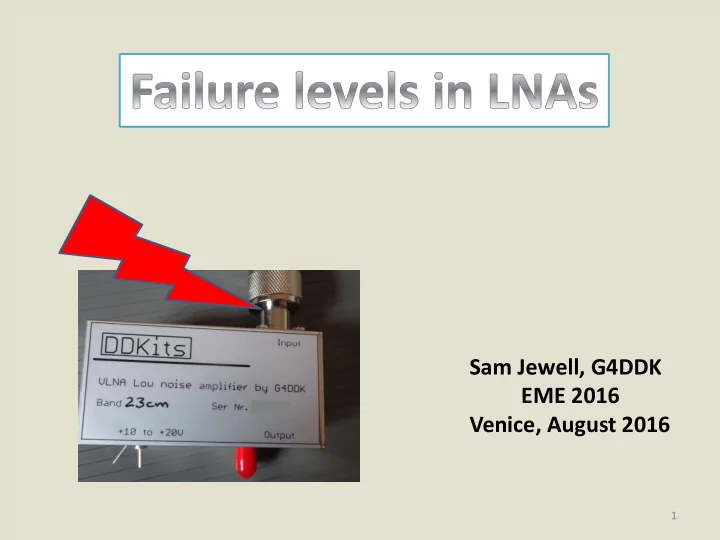

Sam Jewell, G4DDK EME 2016 Venice, August 2016 1
Failure levels in LNAs • Update on the VLNA • Investigation of the failures seen in the VLNA – Nature of the failures – Method of the investigation – Results – Conclusions • Over-coax power feeding 2
VLNA Update Typical VLNA noise figure 0,45 0,4 0,35 0,3 Noise figure (dB) 0,25 0,2 0,15 0,1 0,05 0 0 500 1000 1500 2000 2500 3000 3500 4000 Frequency (MHz) 3
VLNA typical gain Typical gain 40 35 30 25 Gain (dB) 20 15 10 5 0 432 1296 2320 3400 Frequency (MHz) 4
Bias conditions for 23cm • TR1 – Vds = 1.5-1.8 volts – Id = 14.8 – 16mA • TR2 – Vds = 2.94 volts – Id = 66mA 5
Typical bias conditions ~1.6V 2.94V 15mA 66mA 6
2.7pF 2.7nH 13nH LNA input Active device 8.2pF Input noise matching circuit for the VLNA23 7
8
9
Nature of the failures I wanted to investigate two areas in particular 1. Gain/noise figure anomaly 2. Is it better to keep power on during transmit? 10
Gain/noise figure anomaly • Reports that gain appears normal. • Noise figure has increased Manifestation • Preamps appeared to be working normally but signal reports were ‘asymmetric’. Receiving better reports that able to give previously. • Observed in several different preamps, not just the VLNA – ATF53189 PHEMT has been shown to exhibit the same effect at 2m 11
Power on or off? To test claims that the preamp can ‘survive’ higher levels of input signal if the power is left on during transmit 12
Failure tests Testing for the gain/noise figure anomaly and power on/off survival can be tested as a single set of measurements Power on Increase the power into the preamp in steps, soak for a set amount of time, measure noise figure, gain and input return loss at each step. Repeat until preamp fails. Note level at which failure occurs and any changes. Change FETs Power off Repeat above tests until failure. Note level at which failure occurs and any changes. 13
No one wants to deliberately blow up their favourite preamps, do they? 14
Failure tests • ‘Soak period’ varied from 3 minutes to 1 hour at each of the input levels • Noise figure, insertion gain and input return loss measured after each period 15
Early results - Power on Table 1,2,3,&4 100 Noise figure fail 10 Noise figure and gain (dB) Noise figure increase 1 0,1 0 5 10 15 20 Input level (dBm) 16
Early results - power off Table 4*,5 and 6 *Two table 4! 100 Noise figure fail 10 Noise figure and gain (dB) Noise figure increase 1 0,1 0 5 10 15 20 Input level (dBm) 17
Later test results with isolator 18
Latest results - Power ON 100 10 Noise figure & gain (dB) 1 0,1 0 5 10 15 20 Input power (dBm) 19
Latest results - Power OFF 100 10 Noise figure & gain (dB) 1 0,1 0 5 10 15 20 Input power (dBm) 20
Conclusions 1 • The noise figure/gain anomaly has been observed in testing and usually occurs in a limited input range before complete failure • Does not happen every time. 21
Conclusions 2 • Occurs mainly between +12dBm and +17dBm input – Anomaly due to gate puncturing? • It seems to be due to the onset of gate current – Too low to be measured ( maybe picoamps?) – At this level of gate current the gain is largely unaffected • Most devices fail completely between +20dBm and +23dBm input 22
Conclusions 3 • Doesn’t seem to be due to RF heating, directly • It has been observed in both HEMT and PHEMT devices • Second stage (ATF54143 PHEMT) unaffected as first stage limits input signal level 23
Conclusions 4 • Keeping power on during transmit does not confer any advantages – see next slide • VLNA23 is able to withstand a larger input signal than previously recommended – If I can afford the FETs I will check the other bands! • Failure suspicion falls on relay isolation – Need for dynamic rather than static testing - Spikes 24
Power feed over coax Preamp and isolation relay Powered in parallel Option to use 20-24V 120R = 10V @85mA 25
Thank you More details will appear on my web page G4DDK.COM Blog: G4DDK.BLOGSPOT.COM Twitter: DXING 26
Basic HEMT structure 27
Recommend
More recommend